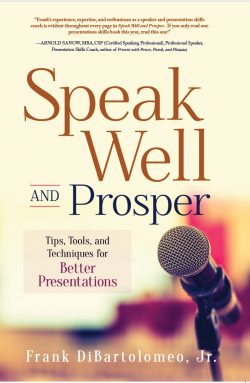Sunday, August 21, 2022

“Bluffing is most effective when done sporadically; bluff too often, and you’ll blow your credibility.”
— Daniel Negreanu
Remember the story of the boy who cried wolf in the forest two times? The lumberjacks in the forest came running to protect the boy against the wolf. But the boy was kidding, at least the first two times. The boy cried wolf a third time when the wolf appeared. However, the lumberjacks thought he was joking. Unfortunately, it was the end of the boy. The boy’s reputation was saying things that were not true. He paid the price for this.
As a speaker, you must be careful to distinguish fact from speculation for your audience.
Your audience will start out believing you until you give them a reason not to believe you. Don’t!
Below are three ways you can maintain your credibility:
Always State Your Source
Your credibility increases when you state the source of your information, even if you are the source.
You can only be the source if your audience has enough information about your background to be convinced you can be a source. A good introduction from a moderator can do this for you. Someone else should recite your introduction rather than you doing so. Your audience will believe your background if someone else presents it rather than you present it.
While it is important to cite sources for your information, your audience comes to hear your thoughts on your presentation subject. Therefore, citing too many sources gives the impression to your audience you do not have the depth of knowledge of your subject. In other words, your credibility will “take a hit.”
There are no rules for what percentage of your presentation you should cite sources. However, my rule of thumb is not more than 30% of your facts should have their sources cited other than you. Again, use your experiences to be the source of the additional 70%. If you cannot use yourself as 70% of the sources in your presentation, perhaps you are not an expert in your subject. In this situation, you should switch to a presentation topic for which you are an expert.
So, always state your sources, whether they are someone else or yourself.
Quite often, though, speakers confuse their audiences because they are not explicit about whether what they say is fact or speculation.
Be Explicit Whether What You are Saying is Fact or Speculation
You must always be vigilant to clarify whether you are speculating or stating a fact.
Speculation does have a purpose in your presentations. It causes your audience to think. When you speculate, you hypothesize a situation. Speculation allows you to ask questions of your audience. This increases audience engagement which is always a good thing.
Below are some examples of where you can be explicit in stating a fact or in speculating, followed by a question to the audience:
Stating a fact – “As a program manager for XYZ corporation, I have interviewed many job candidates for full-time employment. One of the primary requirements of a new job candidate is will they fit in with my team.” (You are the source you have interviewed many job candidates)
Speculating – “The U.S. Forestry Service says the American bison is in danger of extinction. If U.S. Government subsidies were given to farmers to breed more bison, it would avoid extinction. What are some other ways we can increase the bison population?” (Asking a question of an audience)
Stating a fact – “The M.D. Anderson Cancer Institute in Houston, Texas, recently said they were very close to a cure for pancreatic cancer. (The M.D. Anderson Cancer Institute is the source)
So, always state your sources, whether they are someone else or yourself, and be explicit about whether what you say is fact or speculation.
But sources, facts, and speculation are not a presentation message. You must have conclusions to form a message.
How to Draw Your Conclusions
You can draw your conclusions from facts or speculation. Your conclusions are your opinions. The key is to state what your conclusions are based on: facts or speculation.
Because your conclusions, by definition, are your opinion, your audience is free to accept or reject your conclusions. Therefore, one of the most important things you can do is motivate your audience to think about your presentation message during and after your presentation. Stating your conclusions does this.
Whether you base your conclusions on fact or speculation, they must be logical and be supported by what you have said in your presentation.
Fact A (or Speculation A) must be tied to Fact B (or Speculation B) to draw your conclusion.
For instance, if you were a program manager for XYZ corporation, have interviewed many job candidates for full-time employment, and know one of the primary requirements of a new job candidate is will they fit in with your team, you may pair this fact with the fact that technical expertise is another requirement to conclude the most successful job candidates practice thoroughly before arriving for the interview. Both facts are connected and logically follow the conclusion.
So, always state your sources, whether they are someone else or yourself. Be explicit about whether you are saying it is a fact or is speculation and present conclusions to your audience.
Practicing these will make you credible to your audience.
Don’t be the speaker who cried wolf!
Call to Action
Always back up what you say with a source, whether they are you or someone else. If the source is, you think about whether you have the credibility of a source for your presentation subject.
Be explicit whether what you are saying is fact or speculation.
Ensure you present conclusions to your audience. Your audience is expecting them. Don’t disappoint them.
“Accuracy builds credibility”
— Jim Rohn
_____________________________ Frank DiBartolomeo is a retired U.S. Air Force Lieutenant Colonel and award-winning speaker, presentation and interview skills coach, and Professional Member of the National Speakers Association. He was awarded Toastmasters International’s highest individual award, Distinguished Toastmaster because of his outstanding work in public speaking and leadership.
Frank formed DiBartolomeo Consulting International (DCI), LLC (www.speakleadandsucceed.com) in 2007. The mission of DCI is to help technical professionals to inspire, motivate, and influence their colleagues and other technical professionals through improving their presentation skills, communication, and personal presence. Reach Frank at frank@speakleadandsucceed.com and (703) 509-4424.
_____________________________ Don’t miss Frank DiBartolomeo’s latest book!
“Speak Well and Prosper: Tips, Tools, and Techniques for Better Presentations”

Available now at Amazon.com and BarnesandNoble.com